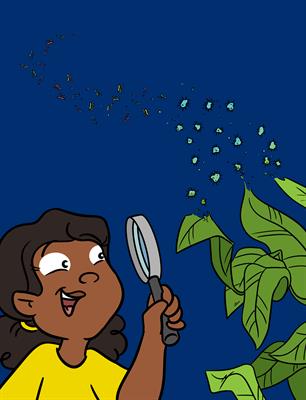
Diversity of the Microbial World
Collection Editors
Francisco Barona-Gomez, Angelica Cibrian-Jaramillo, Edder Bustos-DiazViews
384,925 viewsParticipating Sections
Submission Deadline
Closed
Articles

Biodiversity
23/01/2020
Cycads: Ancient Plants With Bacteria Living in...
Authors
Fernando López Restrepo, Diego Garfias Gallegos, Pablo de...
Biodiversity
10/01/2020
What Are Model Microorganisms?
Authors
Edder D. Bustos-Diaz
Biodiversity
06/12/2019
The Evolution of Bacteria Can Produce Chimeric...
Authors
Gloria Soberón-Chávez
Earth Sciences
04/12/2019
The Role of Microorganisms in the Methane Cycle
Authors
Santiago Cadena, Francisco J. Cervantes, Luisa I. Falcón...
Biodiversity
13/09/2019
Microbialites: What on Earth?
Authors
Alfredo Yanez-Montalvo, Bernardo Águila Salgado, Elizabeth...
Earth Sciences
11/09/2019
Bacteria Have Superpowers to Recycle Soil...
Authors
Yunuen Tapia-Torres, Alberto Morón-Cruz
Biodiversity
29/05/2019
Evolution in a Bottle
Authors
César Aguilar
Biodiversity
27/03/2019
Plants Are Not Animals and Animals Are Not Plants...
Authors
Patricia M. Glibert, Aditee Mitra, Kevin J. Flynn, Per Juel...
Biodiversity
06/02/2019
Hidden Microbial Helpers Living Inside Plants:...
Authors
Rosario Del Carmen Flores-Vallejo, Jorge Luis Folch-Mallol...
Biodiversity
04/02/2019
Why Were the Water and Beaches in West Florida So...
Authors
Patricia M. GlibertAbout this collection
Microbes, or microorganisms, are tiny living beings that cannot be seen by the naked eye. These little guys form one of the oldest living groups on Earth, and are extremely diverse in how they live and what they can do. They can live in many places, from the freezing iciness of glaciers to the boiling hot springs’ waters, to the insides of other organisms, like termites or humans. Since they are virtually everywhere, microorganisms are essential for the biological processes that allow plants and animals to breath, eat and thrive. But how were they able to endure, adapt and flourish constantly over millions of years? The secrets of their success are still within them; coded into their genomes, waiting for us to understand them.Genomes are the repositories of life. Almost every bit of information that allows living beings to live is encoded in their genes. Genes are strung together like the sentences in a book, interacting with each other to create meaning, saving the story of that particular book—or organism—so it can be copied, modified, corrected or enhanced, and then passed on to new generations. After many, many years of studying these ‘books’, we have learned to read and understand them, thanks to the technological innovations of the last decade. Nowadays, it is possible to get the full genome sequence of practically any organism, and compare it with thousands of genomes from other organisms, letting us peek at the secrets that makes each organism who it is – either similar to or different from other organisms. With the current technical abilities, the challenge now is not to obtain the information but to interpret all those strings of the story.
Finding ways to untangle the riddles of genomic information is the work of Genomics, the science that allows us to obtain, analyze and prioritize information among the many stories that we sequence everyday. To do this, Genomics draws from many sciences, like mathematics and computing sciences, making it a truly interdisciplinary endeavor. However, it should not be forgotten that Genomics, as the foundation to modern biological sciences, gives us the opportunity to ask biologically important questions – like who, what, and how? Genomics can be used to identify a microbe and give it a name, to learn about what types of things it can do or places it can live, and to figure out the mechanisms that enable it to survive under particular conditions.
Here, we will deal with some of the basic questions about microbial adaptation, biodiversity, and their relationships with other living beings. We will also focus on the environment, trying to understand how such tiny little creatures are capable of solving their daily problems. Learning about these mechanisms will not only provide us with knowledge about life in general but will also help us to understand these organisms as a fundamental component of our ecosystem, including their harmful and beneficial effects in all aspects of our daily life, which can be translate into useful applications in almost any imaginable way.
----------------------------------------------------
About this Collection:
In addition to the global initiative to discover the Microbial World and Genomics, by contributing to this Collection you will be taking part in local efforts to promote scientific critical thinking in Mexico. Both Science Mentors and Young Minds reviewing the submitted papers have been recruited from local Mexican institutions. The Science Mentors involved in the Collection will be lead by Daniel E. Bustos-Díaz, helping to bring about scientific knowledge to Spanish-speaking countries, as papers will be translated into Spanish after their publication in English.
Would you like to submit to this collection?
For researchers interested in submitting to this Collection, please consult our author guidelines and check that you have all the essentials included before submitting







